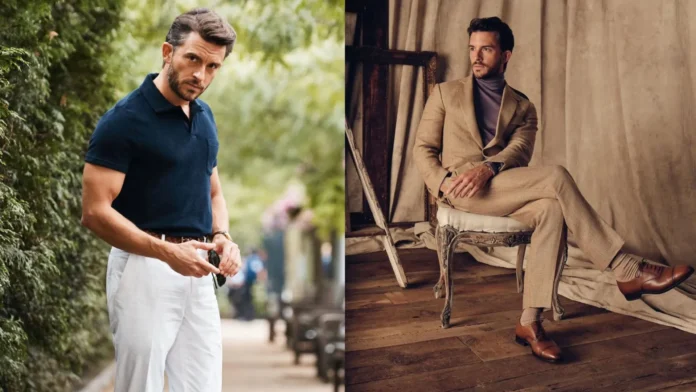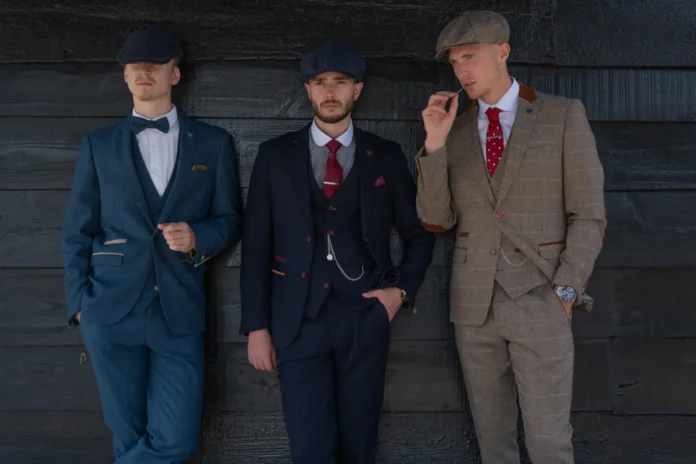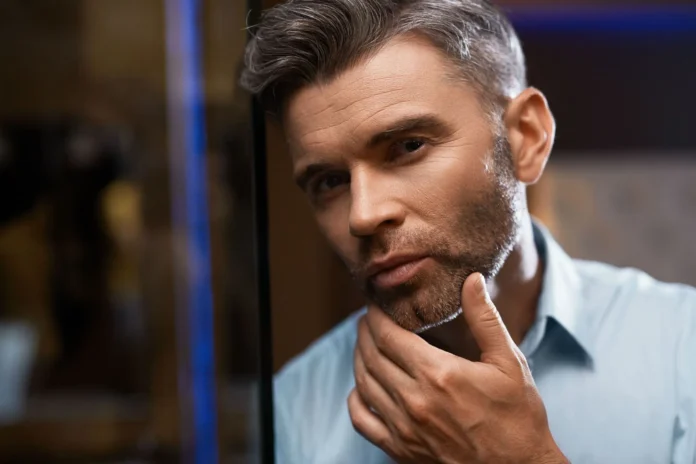Whether a job interview, first date, or neighborhood block party, most people want to make a positive first impression. While factors like body language, listening skills, and confidence all contribute, even subtle appearance details send messages that color others’ initial opinions.
For men looking to project leadership presence from first meetings onward, cultivating simple yet impactful everyday habits around style, grooming and carriage creates commanding first impressions conveying competence and trustworthiness.
Stand Tall ─ Posture, Movement and Carriage
How a man holds and moves his body implicitly communicates capability and power dynamics upon first meeting. Common posture issues like rounded shoulders or insecure gestures inadvertently convey discomfort, self-doubt, or low status. Alternatively, those maintaining upright aligned posture and purposeful movement appear more formidable. The brain instinctually associates upright carriage and open chests with leadership ability.
Additionally, level chin position along with steady, relaxed arm swing while walking projects confidence. Make posture and movement habits priorities by taking regular breaks for shoulder rolls, chest openings and walking practice until proper carriage feels natural.

Strategic Accents ─ Jewelry, Watches, Pens
Beyond well-fitted apparel basics, small masculine accessory touches provide simple yet strategic style finishing. For example, a quality timepiece not only prevents showing up late but broadcasts responsibility. Stylish formal loafers from a brand like Taft give polished footwear for professional settings.
Similarly, subtle symbol pendants, rings or bracelets tell individual stories. Like accent furniture in a room, accessories create masculine interest when used judiciously. When deciding among accessories, consider the desired first impression.
Express Individuality
While first impressions rely on signals of competence, authority and trustworthiness, expressing authentic selfhood also matters for connection. Small styling touches giving a peek into personal interests, values and priorities behind professional roles offer openings for deeper relatedness.
Sporting a tie with subtle stripe detailing or suit with less expected colors breaks stylistic tropes while remaining formal. Geometric details on shoes, belts or bag clasps add artistic undertones. Beards or eyeglasses styles aligning with face shapes reveal stylistic awareness. Such personality cues get conversations going beyond small talk.
Of course, it’s important to balance individuality and professionalism based on situational appropriateness, but infusing original accents makes memorable yet still credible first impressions.

Cultivating Habits For Confident First Impressions
The smallest daily grooming and styling habits shape assumptions upon first meeting others. Making concerted efforts toward forming positive patterns over time lends ease in presenting best selves, even amid nerves. Consider employing the following strategies to build habits that set the stage for confident first impressions:
- Identify an area needing improvement: Posture, accessory accenting or garment care for example. Start small.
- Attach a new habit to an existing routine until it sticks. For instance, polish shoes nightly when returning from work.
- Request accountability from someone else. Ask a partner to observe and give feedback around habits focused on.
- Use visual reminders, like keeping shined shoes by the front door or a posture mirror on the bedroom wall.
- Practice regularly, even without occasions. Wear a tie while reading at home or walk properly during grocery runs. Going through the motions trains muscle memory.
Grooming Cues That Signal Readiness
While posture and accessories influence first impressions, grooming habits send critical subconscious signals about reliability and discipline. Disheveled hair, uneven beards, or neglected nails suggest a lack of routine or regard for details. On the other hand, clean, trimmed nails, moisturized skin, fresh breath, and consistent beard or hair maintenance indicate an individual who respects themselves and others.
Simple grooming practices to adopt include:
- Scheduling a consistent hair or beard trim every two weeks.
- Keeping a small grooming kit (nail clipper, beard comb, travel cologne) in a work bag.
- Using a lightly scented moisturizer to maintain skin tone and texture.
- Checking for collar lint or loose threads before leaving the house.
- Swapping razor blades or electric trimmer heads regularly to avoid uneven cuts.
These habits may seem small but collectively contribute to the polished, ready-for-anything impression that makes others remember you positively.

How to Develop a Signature Style
Beyond wardrobe basics, developing a signature style helps reinforce memorability. A signature style doesn’t require flashy fashion statements—rather, it’s about finding a few personal preferences and sticking with them consistently to build recognition. Think Steve Jobs and his black turtleneck, or a neighbor who always wears patterned socks. These visual consistencies become branding tools.
Steps to define a signature style:
- Choose one standout item: A blazer cut, hat, glasses style, or color palette.
- Keep it versatile: Ensure it works across casual and semi-formal settings.
- Build a collection around that item so it doesn’t feel repetitive.
- Stay true to your comfort zone, or you risk inconsistency.
- Make sure it complements your lifestyle and climate (e.g. breathable fabrics in warm cities).
A signature style simplifies daily dressing decisions while increasing recognizability and cohesion.
The Role of Scent in Memory and Perception
Smell is one of the strongest senses linked to memory. An appropriate and consistent personal scent can trigger long-term positive associations. Scent leaves impressions as much as clothing and posture do, and yet it’s often overlooked. A signature cologne should be subtle, pleasant and align with your style—woodsy and rich for classic styles, citrusy or marine for lighter aesthetics.
| Scent Profile | Ideal For | Examples |
| Woody/Spicy | Traditional, rugged professionals | Cedarwood, sandalwood blends |
| Fresh/Citrus | Youthful, energetic personas | Bergamot, orange, neroli |
| Aquatic/Marine | Clean-cut modern settings | Sea salt, driftwood-inspired |
| Herbal/Aromatic | Calm and intellectual styles | Basil, lavender, sage |
Test colognes on skin rather than paper, as body chemistry alters scents. Apply lightly to pulse points and never overdo it—scent should be discovered, not announced.
Everyday Practice Makes Presence Natural
Charisma is less about dramatic entrances and more about consistency in how you show up. Practicing strong impressions in everyday contexts turns refined style and posture into second nature, not performance. Grocery store visits, commutes, or casual catchups offer regular rehearsal space.
Instead of reserving good habits for interviews or formal events, make them part of your lifestyle. Walk with purpose in the neighborhood. Wear fitted clothes when working from home. Trim your beard before Zoom calls. This consistency trains others (and yourself) to expect confidence and poise at all times. Presence becomes a default, not a switch you flip only on big days.

Conclusion
Like orchestral conductors signaling the experience ahead with a raised baton, men can cultivate simple daily grooming and styling habits that set the stage for commanding first impressions.
Attending to detail, improving posture and movement, adding strategic accessories, and infusing original style accents trains the eyes of others to recognize competence, authority and authenticity from the start.
Over time, attention to detail in small habits helps men feel confident that their leadership is accurately perceived from the start. Small changes compound into lifelong benefits. Start today, and lead every room you walk into—before you even speak.







